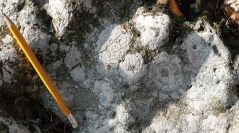

 Geodiversitas
34 (1) - Pages 137-149
Geodiversitas
34 (1) - Pages 137-149Digital photographs of the surface of Serravallian rhodolith-bearing strata from Stazzano (Tertiary Piedmont Basin) Italy have been elaborated by Image-J opensource software (U.S. National Institutes of Health – NIH), to obtain a map of the algal surface in each photograph. The 33 images in the 7 m-thick outcrop, covering a total of 11.53 m2, were complemented by data on rhodolith shape, structure, composition and taphonomy. The Serravallian rhodolith body was produced in a long-lasting infralittoral sedimentary environment and then transported into deeper water by slumping. Although biological and geological definitions of rhodolith-dominated facies are inconsistent in some respects, the image analysis described here allows direct comparison of percentages of rhodolith dominance in discrete fossil rhodolith facies and their living counterparts. The procedures involved are both rapid and inexpensive, so the method appears very useful for carbonate quantification. The calculated algal cover, based only on rhodoliths > 2 cm, ranges from 11.9 to 59.7% (mean 27.3%). The carbonate production rate of the Serravallian rhodolith bed was probably in the range 55 to 136.3 g CaCO3 m-2 yr-1 as calculated for a Brazilian present-day analogue.
coralline algae, rhodolith facies, Miocene, Piedmont, Italy, habitat persistence, carbonate production